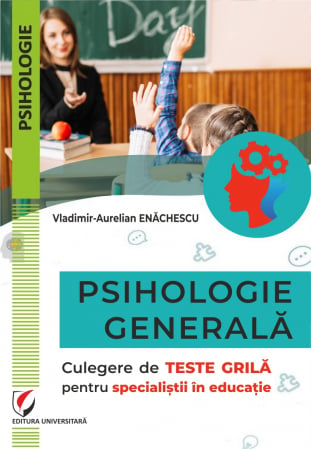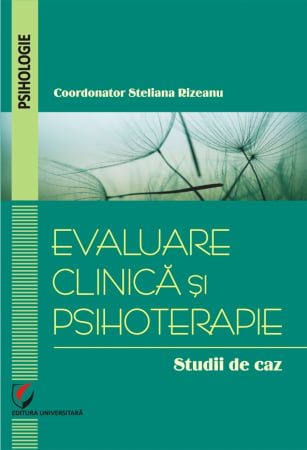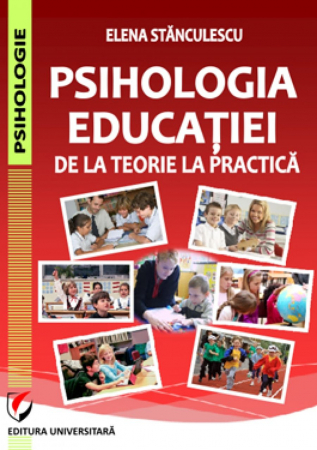ISBN: 978-606-28-0338-4
DOI: 10.5682/ 9786062803384
Publisher year: 2015
Edition: I
Pages: 232
Publisher: Editura Universitară
Author: Eugenia Enachescu
- Description
- Download (1)
- Authors
- More details
- Content
- Reviews (0)
It is observed, for example, that children's play is dominated by imagination, fantasy, inventions, which causes adults to improvise, in their turn, playful variants to welcome the little ones, so spontaneous and often unpredictable. As you will see while going through the work, I have kept the game a well-deserved place, being aware that this way of manifestation typical of childhood knows rapid transformations, unimaginable until recently. The game remains, in the future, an open topic for those who propose to interpret its meanings.
Then, it is found that school learning is no longer appreciated only for its virtues of access to information provided by those who are entitled, but becomes more and more oriented towards the quality of being selective, attractive and useful for those who have to access its resources . The students, the main beneficiaries of learning, are increasingly demanding of the activities in which they are involved, while their teachers encourage them to be serious, disciplined and respectful. The biunivocal teacher-pupil/pupils relationship thus supports continuous balancing, where inspiration, novelty, curiosity are desirable and even necessary, on both sides. The phrase "creative learning" is as current as possible in the education process, but it still requires specialized, theoretical and, at the same time, applied approaches.
The child, at whatever age he is, also needs his own time, beyond the school obligations that cannot be deviated from for socially regulated reasons. That's why an entire (sub)educational system is designed to attract him to his favorite activities, where he can study content other than those learned at school, outline his aspirations for personal affirmation, and relate to other children than those in the class in which it is integrated. Work methods adapted to each type of activity have been created over time and as such, we have given a distinct space to educational events outside the school. I highlighted their importance in the set of concerns that tempt children and I showed how inspiring their communication with the teachers who guide them in the professional circles can be.
More and more limited, the rest of the child's time to develop freely must be respected by adults. Here, parents and relatives can intervene, but with discretion and good intentions, to guide the little one in the myriad of thoughts that can attack him, especially at the threshold of adolescence.
Education, as a system, comes more and more to meet those children who, through their personality formed in the most diverse living conditions and environment, want to perform and prove that they can do it. I noticed some aspects of a psycho-pedagogical nature, inevitably involved in their special training, practiced within work programs designed by those in the position of masters of the field.
Regarding the methodical-scientific research of creativity, I hope that young educators will always be open to new things in their field of study. New themes are emerging, the methods and tools for investigation and data processing are becoming more and more sophisticated, and the criteria for evaluating the research product are becoming more demanding for those who recognize, respect and value the status of an educator.
The present book is, in fact, a transposition in written form of what my childhood revealed to me when I penetrated, as much as possible, into her universe. I saw the children at play, I observed them at work in class, I got to know them closely in their group activities in their assigned locations (palaces and clubs, for example). I asked them, I listened to them, I probed them, with their consent, about the things that particularly interested me. I admired their achievements, more spectacular or more modest, trying to understand what and how results from their efforts to learn and "build" something, according to their own possibilities and ambitions.
Along with the students, the teachers appointed to guide them had the kindness and patience to clarify strictly specialized details and reveal to me the secrets of their work.
The dedication to what they undertake, together with their students, is downright encouraging and even captivating. The book belongs to them. They are, in fact, the authors. Without knowing them, this book would not have come to life.
I give them the thanks they deserve!
sually, an author must specify his target audience and formulate arguments to encourage reading the book. In the present case, the book is addressed, of course, to educators in the system. However, I considered that these professionals are well informed about the phenomenon of creativity, they are good acquaintances of the students they train and they know best what they have to do in their work. That's why, more than these masters, the book is addressed to adults who are around children, having professions in completely different fields than education. Through this book, I tried to leave the door ajar, which usually closes behind the child, so that they, the adults, can see "with their mind's eye" what is happening in the classroom, in the laboratory, in the workshop, in the classroom rehearsals or training. By getting closer to this universe, the adults will position themselves more correctly in relation to the child's expectations and will be more attentive to their creativity, without fears and reservations that it belongs only to some, and for others it would be something unattainable.
Creativity had the right moment of recognition in the school world, with its interpretations of a nature to signal its opportunity in the system. How much, how, who, between what limits, sooner or later? s.a.m.d. they are questions that can only be answered in the rhythm of the events that one student or another encounters during his schooling. Creativity cannot be measured by measures and opportunities, but it can be in the attention of those involved in supporting the ideas that define it. To these attempts is added the present book with its good intentions, but also with the precautions it assumes and which are not few at all.
I had, for my part, teachers, scientific mentors, bosses, who advocated creativity in the profession I practiced, colleagues who imprinted, through their personality, an inspired and stimulating work style, close people who achieved performances of academic level. I have met ordinary people who amazed me with the power of their mind to sweeten the bitterness of everyday life with a wise word, a eloquent gesture or a seemingly bizarre deed and whom I can believe did not become what they really deserved .
For these reasons, and for others left unsaid, I have selected specialized information, I have collected experiences from the life of the school and those who animate it and, in the same context, I have formulated some ideas derived from my own activity as a scientific researcher and teaching staff in training initial of future educators. The result is this product destined to reach wherever it finds its purpose.
I am inspired by the thought that the youngest member of the family, Vlad, promises an artistic future in the field of plastic creation. His brother, Darie, is still looking for his way. Their grandfather, Gheorghe, would be very proud of them.
I dedicate this book to the children who played, learned and dreamed in the Puisor neighborhood of Bucharest, on Coriolan street no. 28-48 (disappeared today, like the entire area of my childhood and student life), to the children I saw growing up, encouraged by parents who were receptive and open to their talent, passions and ambitions, as well as to all those around or far away (distance doesn't matter anymore), who fueled my humor and helped me, through their spirit, to summon it even when it was about to die out.
Dr. Eugenia Enachescu
-
Creativitatea copiilor. O abordare psihopedagogica
Download
Is a graduate of the Faculty of Philosophy, Psychology specialty from the University of Bucharest.
In 1986 he obtained his Ph.D. in psychology with dissertation Success and failure as a motivational factor in student activities.
Professional psychology has shown interest in the school context, becoming an active presence in research and education and training of teaching staff.
She participated in the scientific life by signing articles, papers, specialty papers.
The latest editorial is Lifelong learning. Applications to education.
It is observed, for example, that children's play is dominated by imagination, fantasy, inventions, which causes adults to improvise, in their turn, playful variants to welcome the little ones, so spontaneous and often unpredictable. As you will see while going through the work, I have kept the game a well-deserved place, being aware that this way of manifestation typical of childhood knows rapid transformations, unimaginable until recently. The game remains, in the future, an open topic for those who propose to interpret its meanings.
Then, it is found that school learning is no longer appreciated only for its virtues of access to information provided by those who are entitled, but becomes more and more oriented towards the quality of being selective, attractive and useful for those who have to access its resources . The students, the main beneficiaries of learning, are increasingly demanding of the activities in which they are involved, while their teachers encourage them to be serious, disciplined and respectful. The biunivocal teacher-pupil/pupils relationship thus supports continuous balancing, where inspiration, novelty, curiosity are desirable and even necessary, on both sides. The phrase "creative learning" is as current as possible in the education process, but it still requires specialized, theoretical and, at the same time, applied approaches.
The child, at whatever age he is, also needs his own time, beyond the school obligations that cannot be deviated from for socially regulated reasons. That's why an entire (sub)educational system is designed to attract him to his favorite activities, where he can study content other than those learned at school, outline his aspirations for personal affirmation, and relate to other children than those in the class in which it is integrated. Work methods adapted to each type of activity have been created over time and as such, we have given a distinct space to educational events outside the school. I highlighted their importance in the set of concerns that tempt children and I showed how inspiring their communication with the teachers who guide them in the professional circles can be.
More and more limited, the rest of the child's time to develop freely must be respected by adults. Here, parents and relatives can intervene, but with discretion and good intentions, to guide the little one in the myriad of thoughts that can attack him, especially at the threshold of adolescence.
Education, as a system, comes more and more to meet those children who, through their personality formed in the most diverse living conditions and environment, want to perform and prove that they can do it. I noticed some aspects of a psycho-pedagogical nature, inevitably involved in their special training, practiced within work programs designed by those in the position of masters of the field.
Regarding the methodical-scientific research of creativity, I hope that young educators will always be open to new things in their field of study. New themes are emerging, the methods and tools for investigation and data processing are becoming more and more sophisticated, and the criteria for evaluating the research product are becoming more demanding for those who recognize, respect and value the status of an educator.
The present book is, in fact, a transposition in written form of what my childhood revealed to me when I penetrated, as much as possible, into her universe. I saw the children at play, I observed them at work in class, I got to know them closely in their group activities in their assigned locations (palaces and clubs, for example). I asked them, I listened to them, I probed them, with their consent, about the things that particularly interested me. I admired their achievements, more spectacular or more modest, trying to understand what and how results from their efforts to learn and "build" something, according to their own possibilities and ambitions.
Along with the students, the teachers appointed to guide them had the kindness and patience to clarify strictly specialized details and reveal to me the secrets of their work.
The dedication to what they undertake, together with their students, is downright encouraging and even captivating. The book belongs to them. They are, in fact, the authors. Without knowing them, this book would not have come to life.
I give them the thanks they deserve!
sually, an author must specify his target audience and formulate arguments to encourage reading the book. In the present case, the book is addressed, of course, to educators in the system. However, I considered that these professionals are well informed about the phenomenon of creativity, they are good acquaintances of the students they train and they know best what they have to do in their work. That's why, more than these masters, the book is addressed to adults who are around children, having professions in completely different fields than education. Through this book, I tried to leave the door ajar, which usually closes behind the child, so that they, the adults, can see "with their mind's eye" what is happening in the classroom, in the laboratory, in the workshop, in the classroom rehearsals or training. By getting closer to this universe, the adults will position themselves more correctly in relation to the child's expectations and will be more attentive to their creativity, without fears and reservations that it belongs only to some, and for others it would be something unattainable.
Creativity had the right moment of recognition in the school world, with its interpretations of a nature to signal its opportunity in the system. How much, how, who, between what limits, sooner or later? s.a.m.d. they are questions that can only be answered in the rhythm of the events that one student or another encounters during his schooling. Creativity cannot be measured by measures and opportunities, but it can be in the attention of those involved in supporting the ideas that define it. To these attempts is added the present book with its good intentions, but also with the precautions it assumes and which are not few at all.
I had, for my part, teachers, scientific mentors, bosses, who advocated creativity in the profession I practiced, colleagues who imprinted, through their personality, an inspired and stimulating work style, close people who achieved performances of academic level. I have met ordinary people who amazed me with the power of their mind to sweeten the bitterness of everyday life with a wise word, a eloquent gesture or a seemingly bizarre deed and whom I can believe did not become what they really deserved .
For these reasons, and for others left unsaid, I have selected specialized information, I have collected experiences from the life of the school and those who animate it and, in the same context, I have formulated some ideas derived from my own activity as a scientific researcher and teaching staff in training initial of future educators. The result is this product destined to reach wherever it finds its purpose.
I am inspired by the thought that the youngest member of the family, Vlad, promises an artistic future in the field of plastic creation. His brother, Darie, is still looking for his way. Their grandfather, Gheorghe, would be very proud of them.
I dedicate this book to the children who played, learned and dreamed in the Puisor neighborhood of Bucharest, on Coriolan street no. 28-48 (disappeared today, like the entire area of my childhood and student life), to the children I saw growing up, encouraged by parents who were receptive and open to their talent, passions and ambitions, as well as to all those around or far away (distance doesn't matter anymore), who fueled my humor and helped me, through their spirit, to summon it even when it was about to die out.
Dr. Eugenia Enachescu
INTRODUCTION. CREATIVITY - PHENOMENON OPEN TO THE EDUCATIONAL FIELD / 13
Chapter l. MANIFESTATIONS OF CREATIVITY AT SCHOOL AGE / 31
1.1. Creative potential or latent creativity / 31
1.2. Manifest creativity, as a product / 40
1.3. Creation of children / 46
Selective bibliography / 50
Chapter 2. THE GAME AS A CREATIVITY RESOURCE / 53
2.1. Free, spontaneous play (play) / 59
2.2. Didactic game / 60
2.3. The experimental game / 66
Selective bibliography / 69
Chapter 3. CREATIVE LEARNING / 71
3.1. Play and learning at the early school age / 74
3.2. Creative learning in secondary school: possibilities and limits / 96
3.2.1. Creative learning in the educational process / 97
3.2.2. Creativity in extracurricular activities / 108
3.2.3. Free time and creativity / 123
3.3. The creative adolescent: knowledge and education / 127
Selective bibliography / 136
Chapter 4. CREATIVITY TRAINING / 139
4.1. Literary talent / 142
4.2. Plastic expression: drawing, painting, modeling / 150
4.3. The dance / 168
4.4. Acting / 175
4.5. Sports performance / 181
4.6. Technical innovation/invention / 192
4.7. Scientific investigation / 200
Selective bibliography / 206
Chapter 5. METHODOLOGICAL-SCIENTIFIC RESEARCH OF CREATIVITY IN THE EDUCATIONAL ENVIRONMENT / 209
5.1. Creativity - topic of interest in education research / 210
5.2. Psychopedagogical methods and their application / 211
5.3. The valorization of research in school and extracurricular contexts / 227
Selective bibliography / 230
Appendix 1. Creativity: definitions and interpretations / 233
Appendix 2. Key terms in the study of children's creativity / 237
Appendix 3. Creativity tests / 239
General bibliography / 241

6359.png)
![Children's creativity. A psycho-pedagogical approach - Eugenia Enachescu [1] Children's creativity. A psycho-pedagogical approach - Eugenia Enachescu [1]](https://gomagcdn.ro/domains/editurauniversitara.ro/files/product/large/creativitatea-copiilor-o-abordare-psihopedagogica-681-503653.jpg)














